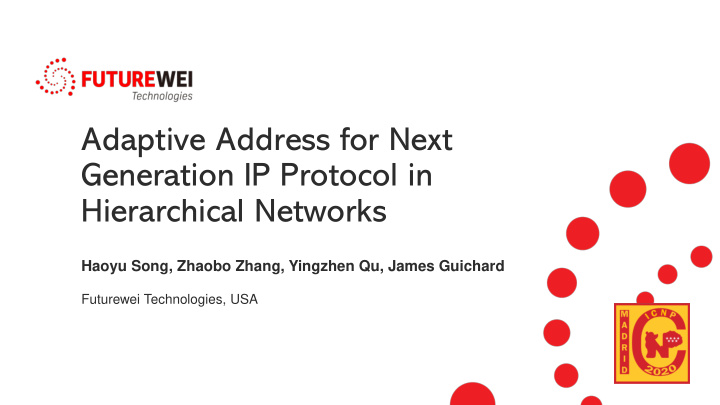



Adaptive Address for Next Generation IP Protocol in Hierarchical Networks Haoyu Song, Zhaobo Zhang, Yingzhen Qu, James Guichard Futurewei Technologies, USA
Motivation • Short messages • Energy sensitive • Delay sensitive • Resource limit Header Overhead • Independent address space • Identity retention • Nondisruptive upgrade Address Extensibility 2
Observation IoT Network Data Center Network • Hierarchical network architecture • Most communication happens between adjacent entities • Communication possible if entities can be uniquely identified mutually 3
Adaptive Address in Hierarchical Networks Entity Address = Network ID + Entity ID Highest Level • Delegate Network ID maintenance and operation Network ID Complete address to networks • Entity only knows and uses its own Entity ID Lowest Level • For communication, entity only get the peer’s Network ID partial address up to the first network level they share Entity ID • E.g., in the lowest level network, entity ID is enough 4
USA Other Countries New York California Los Angeles San Jose New York City From: 123 A Dr. From: 123 A Dr. To: 456 B Rd. To: 456 B Rd. 5
Other Countries USA From: 123 A Dr. San Jose, CA From: 123 A Dr. San Jose, CA To: 456 C Ave. NYC, NY To: 456 C Ave. NYC, NY New York California From: 123 A Dr. San Jose, CA From: 123 A Dr. San Jose To: 456 C Ave. NYC To: 789 C Ave. NYC, NY Los Angeles San Jose New York City From: 123 A Dr. San Jose, CA From: 123 A Dr. To: 456 C Ave. To: 789 C Ave. NYC, NY 6
Address Fields in Header & Border Router’s Function Src. Addr. Length Dst. Addr. Length Egress Source Address (variable) Destination Address (variable) Level Gateway Router (LGR) Ingress • LGR keeps a prefix (network ID) for the network below it Lower level networks ILR • Egress packet: add the prefix to the source & address Entities • Ingress Packet: remove the prefix from the destination address • ILR for intra-level traffic forwarding 7
Interface with IPv4/IPv6 Networks IPv4/IPv6 Network as a lowest IPvn networks within IPv4/IPv6 level network in IPvn network IPv4/v6 Network IPvn Networks Lower IPvn IPvn IPv4/v6 levels of Network Network Network IPvn Hierarchy Hierarchy Networks • IPvn with private addresses (NAT) • IPvn with assigned public address block • LGR → IPT (IP Protocol Translator) 8
Control Plane Design • DHCP • Entity ID assignment • DNS • Hierarchical tree architecture • Name scoping and name overriding • ARP/NDP • LGR as ARP proxy for its prefix • Routing Protocol • Low level network can be a single AS • High level network can contain multiple ASes • With lower level network as stub AS 9
Data Plane Design • End Entity • New IPvn socket supporting IPvn address family • Header convertible to IPv4/IPv6 • Same L2, and L4-L7 protocol stack • Routers • Smaller and simplified forwarding table • No nested prefixes Vn • Network level address aggregation • New functions in LGR • Source and destination address manipulation • New functions in IPT • IP protocol translation 10
Implementation Ver(8) Header ToS/TC Next Header Hop Limit/TTL Length Payload Length SAL DAL SA DA Padding IPVn header format Implementation and Simulation Environment IPVn header parse graph in P4 11
Evaluation I IPv4 IPv6 IPvn Per-Packet Processing Time in Different Types of Routers Forwarding Performance Comparison • Reflect relative performance in software implementation • Insufficient support of variable length header in P4 • Not consider the performance for address lookups 12
Evaluation II 64% 32% Power Saving 16% 8% 4% 2% 1% 1 2 4 8 16 32 64 128 256 512 1024 1500 Packet Payload Length (Byte) Overhead Comparison IoT Power Saving over IPv6 13
Conclusion • Efficient addressing scheme for IoT and data center networks • Future-proof extensible address space • Incrementally deployable from the edge • Fully interoperable with existing IPv4/IPv6 network and end entities • Simplified network control/data plane protocol & implementation • Open source (https://github.com/Fizzbb/ResearchPaper/tree/master/Adaptive- Addresses-for-NG-IP) 14
Thank You.
Recommend
More recommend